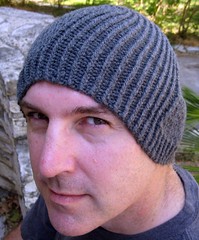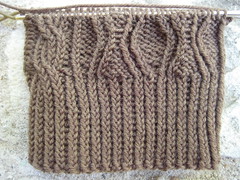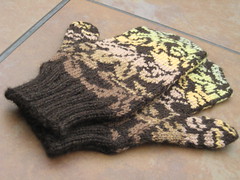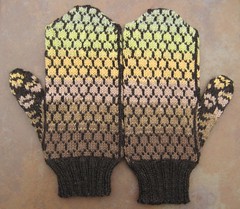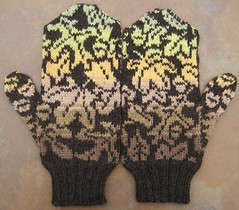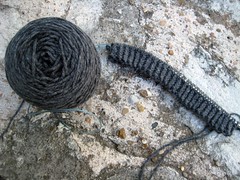I caught State Fair (1945) on Turner Classic Movies recently, and noticed that Fay Bainter’s character, Melissa Frake, was knitting in one scene. I’ve seen this movie plenty of times, but I suppose not since I’ve started knitting. Otherwise, I might have noticed earlier.
In this scene, Ma and Pa Frake are relaxing, high on their recent awards for their prizewinning mincemeat (Ma) and boar (Pa). Ma uses that dainty overhand pencil-holding technique that seems to have been how women learned to knit back in the day, and which I’ve seen in other films before.
Cultural note: I don’t think many women refer to their husbands as “gay dogs” in this day and age any more.
According to the IMDB, Fay Bainter had been on the stage since the age of 3, but she must have found the time to pick up knitting somewhere. She clearly knows what she is doing and is able to act at the same time. But I can’t figure out why she would want to knit a mile-long garter stitch scarf on such tiny needles!
If you’ve never seen this film, it’s kind of interesting. The Technicolor will make your eyes bleed, although it’s fun to see mid 1940s fashions in color rather than black & white. The palette is pretty darn jazzy! And notably, this the only musical that Rogers and Hammerstein wrote for the movies. A newer version came out in the early 60s with Pat Boone and Ann-Margret, but that version was set in Texas, and although, as a Texan, I must say that our state fair is a great state fair, if the film isn’t set in Iowa, you don’t get to hear the film’s best song: All I Owe Ioway!


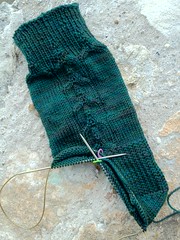 Just when I was at wit’s end,
Just when I was at wit’s end, 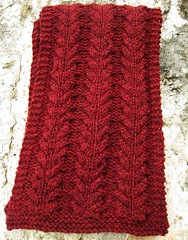

 Just this weekend, Jeff and I were watching Werner Herzog’s
Just this weekend, Jeff and I were watching Werner Herzog’s 
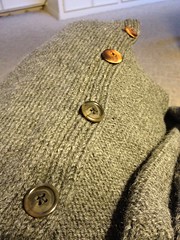
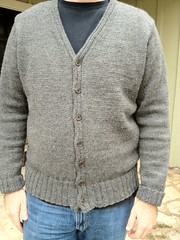
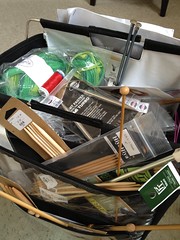
 Which leads me to project number two and this post’s title. Last winter, when Jeff and I were out of town, Kate got into some of my knitting. Some of the stuff she ate I didn’t really care about, but she did manage to mangle a hank of Lorna’s Laces in a one of a kind color. Seriously, the color number is 000, but strangely, it has a dye lot number of 34… I started to toss it, but it had a pristine mate, and knowing that it was irreplaceable made me a bit more dogged (so to speak) in my determination to fix it. So I put this sad shredded mess on a swift, and spent a few hours gently teasing out the pieces and splicing them together. It turns out there were only about a dozen pieces, and two sections were quite long, so I think it was worth it. I’d kind of forgotten about this yarn, but now I’m already thinking of possibilities.
Which leads me to project number two and this post’s title. Last winter, when Jeff and I were out of town, Kate got into some of my knitting. Some of the stuff she ate I didn’t really care about, but she did manage to mangle a hank of Lorna’s Laces in a one of a kind color. Seriously, the color number is 000, but strangely, it has a dye lot number of 34… I started to toss it, but it had a pristine mate, and knowing that it was irreplaceable made me a bit more dogged (so to speak) in my determination to fix it. So I put this sad shredded mess on a swift, and spent a few hours gently teasing out the pieces and splicing them together. It turns out there were only about a dozen pieces, and two sections were quite long, so I think it was worth it. I’d kind of forgotten about this yarn, but now I’m already thinking of possibilities.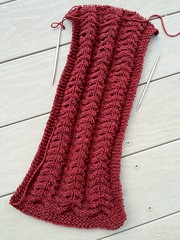 And finally, progress was made on the Pavement Scarf over the past few days. It’s a satisfying pattern, easily memorized within a few pattern repeats. The numbers 6 and 7 figure in the pattern a lot, and it’s clever how it’s reversible – a handy feature for a scarf. Unlike most cabled figures, there is quite a bit of purling into knit stitches and knitting into purl stitches, but once you see where things are going, it does make sense. It is a bit lacier than I thought it would be, and the whole thing could be done on smaller needles, but the drape will be nice and I’m hoping it will fill out when blocked, which this garment sorely needs.
And finally, progress was made on the Pavement Scarf over the past few days. It’s a satisfying pattern, easily memorized within a few pattern repeats. The numbers 6 and 7 figure in the pattern a lot, and it’s clever how it’s reversible – a handy feature for a scarf. Unlike most cabled figures, there is quite a bit of purling into knit stitches and knitting into purl stitches, but once you see where things are going, it does make sense. It is a bit lacier than I thought it would be, and the whole thing could be done on smaller needles, but the drape will be nice and I’m hoping it will fill out when blocked, which this garment sorely needs.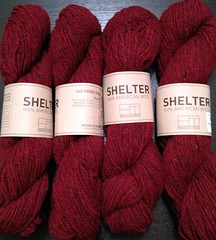 It’s been a bit chilly this week, and while I like my
It’s been a bit chilly this week, and while I like my 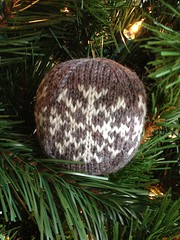 I made one yesterday as a prototype to see how things might work. I had some leftover
I made one yesterday as a prototype to see how things might work. I had some leftover  It was so good to meet her. She was just a delight – so beautiful, and curious and learning things left and right. She absolutely adores her uncles – as any smart niece does – and even took a shine to some of her older cousins. She has only recently learned to walk, but she’s getting good at it fast.
It was so good to meet her. She was just a delight – so beautiful, and curious and learning things left and right. She absolutely adores her uncles – as any smart niece does – and even took a shine to some of her older cousins. She has only recently learned to walk, but she’s getting good at it fast.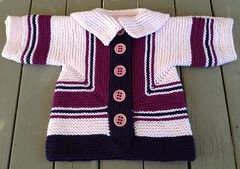 I added these pink buttons this afternoon. They’re yet another shade of pink – and the thread with which they were sewn, stolen from my mother-in-law’s sewing kit, is yet another shade of purple. Five separate colors that go great together! The buttons have six holes. I wasn’t sure what to do with all of them, so I decided to mimic the ridges of garter stitch and do little bars across. The top and bottom holes don’t connect to the sweater – I just ran the thread threw them a few times to make them match the rest. My advice – do not look behind the buttons.
I added these pink buttons this afternoon. They’re yet another shade of pink – and the thread with which they were sewn, stolen from my mother-in-law’s sewing kit, is yet another shade of purple. Five separate colors that go great together! The buttons have six holes. I wasn’t sure what to do with all of them, so I decided to mimic the ridges of garter stitch and do little bars across. The top and bottom holes don’t connect to the sweater – I just ran the thread threw them a few times to make them match the rest. My advice – do not look behind the buttons.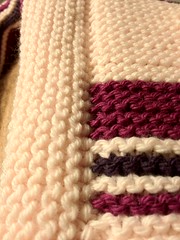
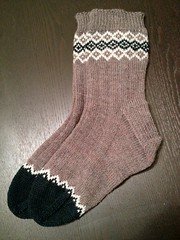



 Fanconi Syndrome is a kidney condition that affects Basenjis. The syndrome causes problems in glucose and acid levels in urine, and can lead to kidney failure. It usually doesn’t manifest itself until a dog is between 4 and 7 years of age, by which time some dogs have already had offspring. Thus it has passed down from generation to generation. It affects somewhere around 10% of the U.S. Basenji population. It’s a nasty disease, but if caught early, it’s treatable. Catching it early, for us, involved holding Clinistix urine testing strips under (Pona) or behind (Kate) our dogs once a month to see if they had high glucose levels. Fun!
Fanconi Syndrome is a kidney condition that affects Basenjis. The syndrome causes problems in glucose and acid levels in urine, and can lead to kidney failure. It usually doesn’t manifest itself until a dog is between 4 and 7 years of age, by which time some dogs have already had offspring. Thus it has passed down from generation to generation. It affects somewhere around 10% of the U.S. Basenji population. It’s a nasty disease, but if caught early, it’s treatable. Catching it early, for us, involved holding Clinistix urine testing strips under (Pona) or behind (Kate) our dogs once a month to see if they had high glucose levels. Fun! Until recently, there was an indirect test for the likelihood of a dog developing Fanconi later in life, called a linked marker test. They could look at several indicators and calculate probability, but as yet, they hadn’t identified the exact mutation. In late August, Dr. Gary Johnson of the Dept. of Veterinary Pathobiology at the University of Missouri, was able to sequence the complete genome of Miranda, a Basenji with Fanconi Syndrome and compare it to other dog genomes. He identified the exact gene causing the problem. As far as Dr. Johnson knows, it’s the first first inheritable dog disease problem solved through genome sequencing. Dr. Johnson’s
Until recently, there was an indirect test for the likelihood of a dog developing Fanconi later in life, called a linked marker test. They could look at several indicators and calculate probability, but as yet, they hadn’t identified the exact mutation. In late August, Dr. Gary Johnson of the Dept. of Veterinary Pathobiology at the University of Missouri, was able to sequence the complete genome of Miranda, a Basenji with Fanconi Syndrome and compare it to other dog genomes. He identified the exact gene causing the problem. As far as Dr. Johnson knows, it’s the first first inheritable dog disease problem solved through genome sequencing. Dr. Johnson’s 
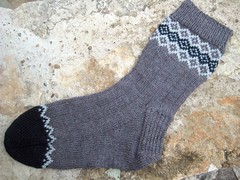
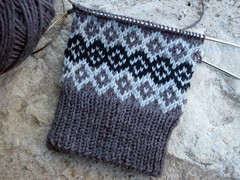


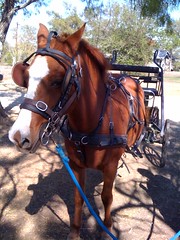
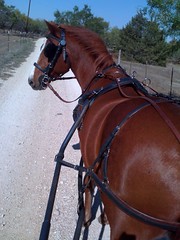
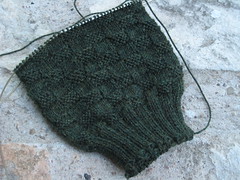 I’m waiting on some yarn to arrive for some socks I’ve had in the back of my mind for a while, but I needed something on the needles in the meantime, so this weekend I started a pair of socks from a pattern called
I’m waiting on some yarn to arrive for some socks I’ve had in the back of my mind for a while, but I needed something on the needles in the meantime, so this weekend I started a pair of socks from a pattern called 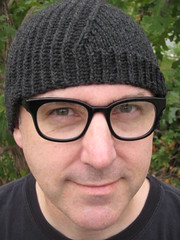
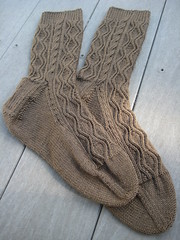
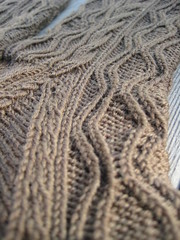



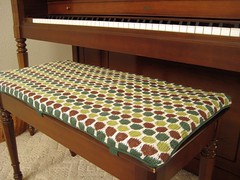
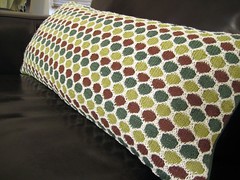 Some of my fondest childhood memories surround this instrument. My mom learned to play the piano at a young age. I was about 6 or so when she got this piano, and I remember being amazed on the day it arrived when she just sat down and started playing. I’d never seen her do anything remotely like this and suddenly she was making the most amazing sounds. She was drawn to it when she was stressed or just needed to clear her mind – she seemed to be able to play just about anything, but she mostly loved hymns. I always admired how she could play without looking at the music much and while holding a conversation. Later, both my sister and I learned to play it, and just about drove our brother crazy with our constant practicing.
Some of my fondest childhood memories surround this instrument. My mom learned to play the piano at a young age. I was about 6 or so when she got this piano, and I remember being amazed on the day it arrived when she just sat down and started playing. I’d never seen her do anything remotely like this and suddenly she was making the most amazing sounds. She was drawn to it when she was stressed or just needed to clear her mind – she seemed to be able to play just about anything, but she mostly loved hymns. I always admired how she could play without looking at the music much and while holding a conversation. Later, both my sister and I learned to play it, and just about drove our brother crazy with our constant practicing. 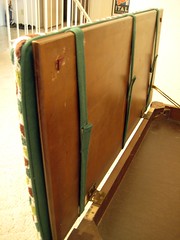
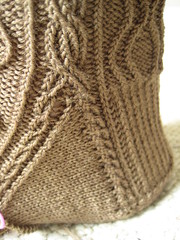
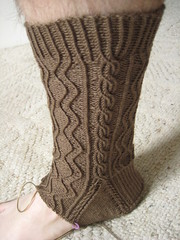 The main hourglass pattern is pretty easy to follow. Out of the 16 rounds in the pattern, stitches are flipped in only 6 of those rounds. The twisting of the knits really makes these lines pop – almost a 3-D effect if the light is just right. And although I was worried that the extra stitches and the US1 (2.25mm) needle I’m using (I usually use a US0) would make these socks too big, it seems to be fitting just fine. Oh, and I love how the travelling stitches and cables grow organically out of the ribbing at the cuff. So much to love about these!
The main hourglass pattern is pretty easy to follow. Out of the 16 rounds in the pattern, stitches are flipped in only 6 of those rounds. The twisting of the knits really makes these lines pop – almost a 3-D effect if the light is just right. And although I was worried that the extra stitches and the US1 (2.25mm) needle I’m using (I usually use a US0) would make these socks too big, it seems to be fitting just fine. Oh, and I love how the travelling stitches and cables grow organically out of the ribbing at the cuff. So much to love about these! The Red Tent
The Red Tent
